Introduction
Female Genital Mutilation (FGM) is a deeply entrenched and harmful practice that affects millions of girls and women worldwide, particularly in Africa. FGM has severe physical and emotional consequences, including immediate health risks, long-term complications, and psychological trauma. According to UNICEF, at least 200 million girls and women alive today have undergone FGM, with a significant number residing in Africa[1]. Nigeria, despite progress in legislative measures, remains one of the countries with the highest prevalence rates of FGM.

Prevalence of Female Genital Mutilation in Africa and Nigeria
FGM involves the partial or total removal of external female genitalia, often performed on young girls without their consent. It is carried out for cultural, religious, or social reasons but has no medical benefits. The World Health Organization (WHO) categorizes FGM into four types, all of which pose severe health risks.[2]
FGM is most common in West, East, and North-Eastern Africa, with Somalia (98%), Guinea (95%), and Djibouti (93%) reporting the highest prevalence rates. Despite a decline in recent years, Nigeria still records a significant number of cases. Nigeria accounts for the third highest number of women and girls who have undergone FGM worldwide, with an estimated 19.9 million survivors.[3] According to the Nigeria Demographic and Health Survey (NDHS) 2018, about 20% of women aged 15-49 have undergone FGM, and among girls aged 0-14, the prevalence is approximately 19%.[4]
The practice varies across regions in Nigeria, with the highest prevalence found in the South-West (35%) and South-East (32%), while the North-Central and North-West report lower rates. Factors such as ethnicity, cultural beliefs, and lack of education play a crucial role in its persistence.[5]
The Role of Education in Preventing Female Genital Mutilation
Education is one of the most effective tools in the fight against FGM. It catalyzes change, with the potential to disrupt harmful traditions and empower communities to abandon FGM. FGM is more common among daughters of uneducated women, and it decreases significantly as a mother’s educational level increases.[6] Girls with primary school-educated mothers are 40% less likely to be cut than those with uneducated mothers. In many countries, women with a secondary education are even less likely to pass down the practice of FGM to their children. In Ethiopia, levels of FGM are 85 per cent lower among daughters of women with a secondary education versus those who are uneducated.[7] By raising awareness and providing factual information, education helps communities understand the harmful consequences of the practice and encourages its abandonment. Education is also very cardinal in:
- Dispelling Myths and Misconceptions
Many communities believe that FGM is necessary for cultural, religious, or hygiene reasons. However, no religious scripture mandates FGM, and the practice does not contribute to cleanliness. Education helps debunk these myths and highlights the dangers of FGM.
- Promoting Human Rights
FGM is a violation of human rights, particularly the rights of girls and women to bodily integrity, health, and freedom from violence. Educating communities about human rights fosters a culture of respect and protection for women.
- Empowering Girls and Women
Knowledge equips girls and women with the confidence to resist all forms of practices, including FGM and advocate for their rights. Educated women are more likely to reject the practice for their daughters and influence their communities.

Awareness-Raising Strategies
Education must be complemented by effective awareness-raising strategies, including:
- Community Outreach: Engaging with traditional and religious leaders, healthcare providers, and educators to influence change at the grassroots level.
- Media Campaigns: Utilizing radio, television, newspapers, and social media platforms to spread awareness about the dangers of FGM.
- School-Based Programs: Integrating FGM education into curricula to educate young boys and girls about the issue.
- Community Events: Organizing seminars, workshops, and discussions to foster dialogue and awareness.
Challenges and Opportunities
While education and awareness are essential in preventing FGM, there are challenges to overcome. These challenges include:
- Cultural and Social Norms: FGM is deeply rooted in traditions, making behavioral change slow and difficult.
- Limited Access to Education: Many girls, especially in rural areas, lack access to quality education, reducing opportunities for awareness.
- Resistance to Change: Some communities view efforts to end FGM as an attack on their cultural identity.
Despite these challenges, there are opportunities for progress and channels to leverage on. They are:
- Growing Global and Local Advocacy: Increased awareness and activism are leading to greater support for anti-FGM initiatives.
- Government and Legal Support: Many African countries, including Nigeria, have enacted laws banning FGM, offering a legal framework for action.
- Community Involvement: More local leaders and organizations are embracing the movement against FGM, making interventions more effective.

Recommendations
To combat FGM effectively, a multi-faceted approach is required:
- Expand Education and Awareness Efforts: Governments and NGOs should invest in education programs targeting communities where FGM is prevalent.
- Strengthen Legal Frameworks: Laws prohibiting FGM must be enforced with strict penalties for perpetrators.
- Promote Community-Based Interventions: Work with community leaders to shift cultural attitudes and encourage alternative rites of passage.
- Increase Funding for Anti-FGM Programs: Governments, donors, and organizations should allocate more resources to awareness campaigns, education, and support for survivors.
- Support Victims and Survivors: Providing healthcare, psychological support, and reintegration programs for girls and women affected by FGM.
- Engage Men and Boys: Encouraging male involvement in advocacy efforts to challenge patriarchal norms that sustain FGM.
Conclusion
Ending FGM requires a sustained and collective effort involving education, legal enforcement, and community engagement. By educating and empowering communities – women and girls, boys and men – with knowledge, dispelling harmful myths, and fostering respect for human rights, we can protect girls and women from this harmful practice. Governments, civil society organizations, and individuals must continue to advocate for a future where no girl suffers the physical and emotional consequences of FGM.
References
[1] 28 Too Many (2016) Country Profile: FGM in Nigeria. Available at http://www.28toomany.org/countries/ Nigeria/..” (Accessed: January 31, 2025).
[2] “Female Genital Mutilation”. Available at https://nationalfgmcentre.org.uk/fgm/. Accessed January 31, 2025
[3] UNICEF Press Release 2022. Available at https://www.unicef.org/nigeria/press-releases/unicef-warns-fgm-rise-among-young-nigerian-girls. Accessed January 31, 2025
[4] Onah, C.K., Ossai, E.N., Nwachukwu, O.M. et al. Factors associated with the practice of and intention to perform female genital mutilation on a female child among married women in Abakaliki, Nigeria. BMC Women’s Health 23, 376 (2023). https://doi.org/10.1186/s12905-023-02537-3
[5] 28 Too Many (2016) “ FGM in Nigeria: Key Findings” Available at https://www.fgmcri.org/media/uploads/Country%20Research%20and%20Resources/Nigeria/nigeria_key_findings_v3_(July_2021). Accessed January 31, 2025
[6] Yerima, TY. and DF Atidoga, Eradicating the Practice of Female Circumcision/Female Genital Mutilation in Nigeria within the Context of Human Rights. Journal of Law, Policy and Globalization 28: 201, 2014
[7] UNICEF Data Brief “ The Power of Education To end FGM” . Available at https://data.unicef.org/resources/the-power-of-education-to-end-female-genital-mutilation/. Last Accessed on January 31, 2025








